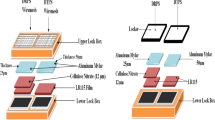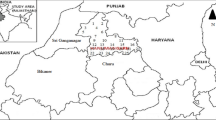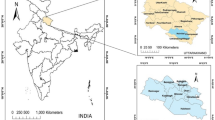Abstract
Present study has been carried out for dose estimation from attached/unattached progeny fractions of radon and thoron using wiremesh capped DTPS/DRPS. The measured annual average attached radon/thoron progeny concentration (EERCA and EETCA) in the dwellings has been found to be 5.93 Bqm−3 and 0.43 Bqm−3 respectively. The calculated inhalation dose due to unattached fractions of radon progeny has been found to vary from 0.01 to 40.54 mSvy−1 with mean value of 5.48 mSvy−1 due to mouth breathing and from 0.01 to 9.42 mSvy−1 with mean value of 1.5 mSvy−1 for nasal breathing and the annual effective dose due to radon and thoron progeny has been found to vary from 0.17 to 1.11 mSvy−1and from 0.06 to 0.47 mSvy−1 respectively. These values lie well below the recommended safe range of 4 mSvy−1 at work places and 14 mSvy−1 at residential places (ICRP (International Commission on Radiological Protection) in Radiological protection against radon exposure. ICRP Publication ref 4836-9756-8598. ICRP, Stockholm, 2018). Hence, the indoor air in the study area is safe for breathing and poses no radiological health risk to the residents.












Similar content being viewed by others
References
UNSCEAR (United Nation Scientific Committee on the effects of Atomic Radiations) (2000) Sources, effects and risks of ionizing radiation. United Nations, New York
Tokonami S, Young M, Yonehara H (2002) Simple discriminative measurement techniques for radon and thoron concentrations with a single scintillation cell. Rev Sci Instrum 73:69. https://doi.org/10.1063/1.141621
Singh P, Siaini K et al (2015) Attached, unattached fraction of progeny concentrations and equilibrium factor for dose assessments from 222Rn and 220Rn. Radiat Environ Biophys. https://doi.org/10.1007/s00411-016-0656-3
Mayya YS, Mishra R et al (2010) Wiremesh capped deposition sensors: novel possessive tool for coarse fraction flux estimation of radon thoron progeny in indoor environments. Sci Total Environ 409:378–383
Mishra R et al (2010) Response of direct thoron progeny sensors (DTPS) to various aerosol concentrations and ventilation rates. Nucl Inst Methods Phys Res B 268:671–675
Sapra BK, Kothalkar PS et al (2011) Mitigating Particulates Emitted by mosquito coils using unipolar ionisers: implication to human respiratory tract system. Indoor Built Environ 22(2):347–259
Eppan KP, Sapra BK, Mayya YS (2007) A novel methodology for online measurement of thoron using Lucas scintillation cell. Nucl Instrum Methods Phys Res 572:922–925
Sharma S, Kumar A et al (2018) Assessment of progeny concentrations of 222Rn/220Rn and their related doses during deposition based direct progeny sensors. Environ Sci Pollut Res 25:11440–11453
Stevanovic N, Markvic VM, Urosevic V, Nikezic D (2009) Determination of parameters of the Jacobi room model using Brownian motion model. Health Phys 96(1):48–54
Zhao B, Wu J (2006) Modeling particle deposition from fully developed turbulent flow in ventilation duct. Atmos Environ 40(3):457–466
Stevanovic N, Markvic VM, Urosevic V, Nikezic D (2009) Deposition rates of unattached and attached radon progeny in room with turbulent airflow and ventilation. J Environ Radioact 100(7):585–589
Rout RP, Mishra R et al (2014) Measurement of 222Rn and 220Rn decay product deposition velocities using SSNTD based passive detectors. J Radional Nucl Chem 302:1495–1499
Mehra R et al (2015) Estimation of attached and unattached progeny of Rn-222 and Rn-220 concentration using deposition-based progeny sensors. Radiat Prot Dosim 2015:1–5
Ramola RC, Prasad M, Kandari T et al (2016) Dose estimation derived from the exposure to radon, thoron and their progeny in the indoor environment. Sci Rep. https://doi.org/10.1038/srep31061
Butterweck G, Schuler C, Vessu` G, et al (2002) Experimental determination of the absorption rate of unattached radon progeny from respiratory tract to blood. Radiat Prot Dosimetry 102:343–348
Prasad M, Bossew P et al (2017) Dose assessment from the exposure to attached and unattached progeny of radon and thoron in indoor environment. Acta Geophys. https://doi.org/10.1007/s11600-018-0111-8(0123456789
Chamberlain AC, Dyson ED (1956) The dose to the trachea and bronchi from the decay products of radon and thoron. Br J Radiol 29:317–325
Kansal S et al (2011) Measurement of indoor radon concentration in the dwellings of Western Haryana, India, for health risk assessment. Appl Rad Isot 70:1110–1112
Garcis-Tober J (2018) A comparative study of indoor radon levels between two similar dwellings using CONTAM software. Environments 5:59
Chahuan RP, Kumar A, Chuhan N et al (2016) Ventilation effect on indoor radon-thoron levels in the dwellings and correlation with soil exhalation rates. Indoor Built Original Pap Environ 25(1):203–212
Nazir, S., Simnani, S., Sahoo, B.K. et al. (2020) Monitoring geothermal springs and groundwater of Pir Panjal, Jammu and Kashmir, for radon contamination. J Radioanal Nucl Chem 326:1915–1923. https://doi.org/10.1007/s10967-020-07451-8
Statistics Korea, lung cancer incidence data. 2011–2013. https//kosis.kr/wn search/total/totalsearchjsp. Acessed 04 Jan 2016
Yoon JY, Lee J-D et al (2016) Indoor radon exposure and lung cancer: a review of ecological studies. Annals Occup Environ Med 28:15
WHO (2009) Indoor Radon a Public Health Perspective. Public Health Perspective
Sahoo BK, Sapra BK et al (2013) A new pinhole discriminated 222Rn/220 Rn passive measurement device with single entry face. Radiat Meas 58:52–60
Singh B, Kant K et al (2019) A study of seasonal variations of radon, thoron and their progeny levels in different types of dwellings in Faridabad district. J Radioanalyt Nucl Chem, Southern Haryana, India. https://doi.org/10.1007/s10967-019-06544-3
Nazir S, Simnani S et al (2019) Dose estimation of radioactivity in groundwater of Srinagar City, Northwest Himalaya, employing fluorometric and scintillation techniques. Environ Geochem Health. https://doi.org/10.1007/s10653-020-00576-5
Singla AK, Kansal S, Mehra R (2021) Quantification of radon contamintaion in drinking water of Rajasthan, India. J Radioanal Nucl Chem 327(3):1149–1157
Rani S, Kansal S, Singla AK, Mehra R (2021) Radiological risk assessment to the public due to the presence of radon in water of Barnala district. Environ Geochem Health, Punjab, India. https://doi.org/10.1007/s10653-021-01012-y
Darby S, Hill D et al (2005) Radon in homes and risk of lung cancer: collaborative analysis of individual data from 13 European case-control studies. Be Med J 330:223–226
Cavallo A (2000) The radon equilibrium factor and comparative dosimetry in homes and mines. Radiat Prot Dosim 92(4):295–298
Nazir, S., Simnani, S., Mishra, R. et al. (2020) Simultaneous measurements of radon, thoron and their progeny for inhalation dose assessment in indoors of Srinagar, J&K, India. J Radioanal Nucl Chem 325: 315–328. https://doi.org/10.1007/s10967-020-07233-2
Nazir, S., Sahoo, B.K., Rani, S. et al. (2021) Radon mapping in groundwater and indoor environs of Budgam, Jammu and Kashmir. J Radioanal Nucl Chem 329:923–934. https://doi.org/10.1007/s10967-021-07856-z
Singla AK, Kansal S, Mehra R (2021) Dose distribution to individual tissues and organs due to exposure of alpha energies from radon and thoron to local population of Hanumangarh, Rajasthan, India. J Radioanal Nucl Chem 327(3):1073–1085
Handbook on Radon Transport Models and Measurement methods (2011) Radiological. Physics and Advisory Division, Health Safty and Environment Group, BARC, Mumbai, 400085
Rohit M et al (2016) Estimation of Radiological Dose from Progeny of 222Rn and 220Rn using DTPS/DRPS and Wire-mesh capped progeny sensors. Dose Response. https://doi.org/10.1177/155932581660883
Mishra R, Sapra BK, Mayya YS (2014) Multi parametric approach towards the assessment of radon and thoron progeny exposures. Rev Sci Instrum 85(2): 022105
Knuston EO (1988) Modelling indoor concentrations of radon’s decay products. In: Nazaroff WW, Nero Av J (eds) Radon and its decay products in indoor air. Wiley, New York, pp 161–199
Porestendorfer J (1996) Radon: measurement related to dose. Environ Int 22(1):563–583
Bennet WD, Zeman KL et al (2003) Nasal distribution to breathing with exercise: effect of race and gender. J Appl Physoil 95(2):497–503
ICRP (International Commission on Radiological Protection) (1993) Protection against radon-222 at home and at work, Oxford: Pergamon Press; ICRP Publication 65; Ann ICRP 23(2)
Porstendofer J (2001) Physical parameters and dose factors of the radon and thoron decay products. Radiat Prot dosim 94(4):365–373
United Nations Scientific Committee on the Effect of Atomic Radiation (UNSCEAR) (2006) Report to the general assembly with scientific annexes, Vol II, Scintific annexes C, D, E. United States, New York
Mayya YS, Eappen KP, Nimbi KSV (1998) Methodology for mixed field inhalation dosimetry in monazite areas using a twin- cup dosimeter with three track detectors. Radiat Protect Dosim 77(3):177–184
ICRP (International Commission on Radiological Protection) (2018) Radiological protection against radon exposure. ICRP Publication ref 4836-9756-8598. ICRP, Stockholm, Sweden
Acknowledgements
We appreciate the prodigious efforts of Sandeep Kanse (Principle Collaborator for Research Project) BARC, Mumbai, India for his continuous support. The authors are thankful to BRNS-DAE-GoI for providing financial assistance (Grant No. 36(4)/14/29/2016-BRNS/36032) in carrying out research work and also to the residents of the area for their cooperation in indoor sampling. A sincere thank you to Syed Ensha for proof-reading of this manuscript.
Author information
Authors and Affiliations
Contributions
Amit Kumar Singla and Sandeep Kansal have designed the research plan and prepared the manuscript with contribution of Supriya Rani and Rohit Mehra. Amit Kumar Singla carried out all the field work for sample collection and analysis in the lab. All authors have read and approved the final manuscript.
Corresponding author
Ethics declarations
Conflict of interest
On behalf of all authors, the corresponding author states that there is no conflict of interest.
Consent to publish
All authors have read and approved the final manuscript.
Additional information
Publisher's Note
Springer Nature remains neutral with regard to jurisdictional claims in published maps and institutional affiliations.
Rights and permissions
About this article
Cite this article
Singla, A.K., Kansal, S., Rani, S. et al. Radiological risk assessment due to attached/unattached fractions of radon and thoron progeny in Hanumangarh district, Rajasthan. J Radioanal Nucl Chem 330, 1473–1483 (2021). https://doi.org/10.1007/s10967-021-07930-6
Received:
Accepted:
Published:
Issue Date:
DOI: https://doi.org/10.1007/s10967-021-07930-6




